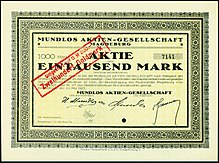Heinrich Mundlos
Heinrich Mundlos (born December 23, 1836 in Barby , † April 27, 1928 in Magdeburg ; full name Friedrich Heinrich August Mundlos ) was a German entrepreneur and inventor who worked as a sewing machine manufacturer .
Life
Heinrich Mundlos was born as the son of the master shoemaker Friedrich Mathias Mundlos . He first learned the shoemaker's trade and went on a journey through Germany. He then turned to metalworking and learned this craft in Berlin , Dresden , Königsberg and Magdeburg. In 1863 he founded a sewing machine factory together with Hermann Schulz in Magdeburg. Initially, the Mundlos & Schulz company based itself on the Singer sewing machine system, later on that of the British Elias Howe . Mundlos' partner left in 1874 and he continued to run the company on his own until his new partner, Rudolf Arendt, joined in 1876. Six years later, the first very smooth sewing machine, designed by Mundlos itself, came out under the Victoria brand and helped the company achieve its breakthrough. Arendt, who was initially only a representative and from 1882 a partner, took care of the international market. In addition to sewing machines of all sizes, wringing and washing machines were also sold in Europe and as far as Russia. In 1884 the company moved to its new location on the property at Lübecker Strasse 8 in Magdeburg. Around 1890 the range was expanded to five sewing machine sizes.
In 1901 the first ring ship machine came on the market, which enabled a larger reel size. The production program now comprised eleven different machines. In 1910 the patented “high-speed runner” was developed. At that time, the company was already exporting to Asia and South America. Inventions such as a semi-automatic hole embroidery machine and a buttonhole sewing machine in 1913 and 1914 further strengthened the company's position. After Arendt died in 1918, Mundlos converted it into a stock corporation in 1920 and took over the chairmanship of the supervisory board in old age. Family members of Arendt and Mundlos held important positions. In 1925 the high-speed zigzag machine came on the market, which quickly established itself in the private household sector, and in 1927 the first electrically powered commercial sewing machine. When Mundlos died, about 1,300 people were employed. The company continued to flourish until the beginning of the Second World War , when it was obliged to supply elements essential to armament from the wood and metal processing sector. On January 16, 1945, most of the factory and the company's own museum fell victim to a bomb attack; what was preserved was transported to the Soviet Union as reparations .
Honor
The city of Magdeburg named a street on the former factory premises as Heinrich-Mundlos-Ring in his honor .
literature
- Werner Hohaus: Mundlos, Heinrich. In: Guido Heinrich, Gunter Schandera (ed.): Magdeburg Biographical Lexicon 19th and 20th centuries. Biographical lexicon for the state capital Magdeburg and the districts of Bördekreis, Jerichower Land, Ohrekreis and Schönebeck. Scriptum, Magdeburg 2002, ISBN 3-933046-49-1 , p. 493 f.
- Peter Wilhelm: Old German sewing machines. A manual for collectors and sewing machine lovers. 1987, pp. 77-80.
- Peter Zilvar: The zigzag sewing machine was invented in Magdeburg. In: Volksstimme Magdeburg from March 7, 1998.
Web links
| personal data | |
|---|---|
| SURNAME | Mundlos, Heinrich |
| ALTERNATIVE NAMES | Mundlos, Friedrich Heinrich August (full name) |
| BRIEF DESCRIPTION | German entrepreneur and inventor, sewing machine manufacturer |
| DATE OF BIRTH | December 23, 1836 |
| PLACE OF BIRTH | Barby |
| DATE OF DEATH | April 27, 1928 |
| Place of death | Magdeburg |


